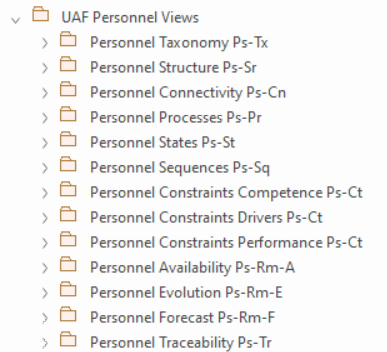| Prev | Next |
UAF Personnel Views
The UAF 1.2 Personnel Viewpoints form a dedicated domain within the Unified Architecture Framework, concentrating on the human aspects of enterprise architecture. This domain was separated from others due to the inherent complexity of modeling human factors, allowing organizational considerations to be addressed in their own space. It defines human actors, their roles, interactions, and organizational dependencies. Over time, the domain has been expanded to support an integrated model that encompasses a wide range of human factors, such as competencies, training, workload, situational awareness, safety, and organizational culture.
These viewpoints give architects a structured way to analyze and document the human dimension of complex systems, clarifying how people align with organizational structures, their responsibilities and capabilities, and their interactions with both colleagues and technological systems in the broader enterprise architecture environment.

UAF Personnel Views
|
Personnel Taxonomy Ps-Tx |
Stakeholders: Project Managers, Project Portfolio Managers, Enterprise Architects. Concerns: Types of projects and project milestones. Definition: Shows the taxonomy of types of projects and project milestones. |
|
Personnel Structure Ps-Sr |
Stakeholders: Project Managers. Concerns: Relationships between types of projects and project milestones. Definition: Provides a template for an actual project(s) road map(s) to be implemented. |
|
Personnel Connectivity Ps-Cn |
Stakeholders: Systems Engineers, IT Architects, Solution Providers, Implementers. Concerns: Capture the interactions between resources. Definition: Summarizes interactions between resources of information, systems, personnel, natural resources, etc. and the functions that produce and consume them. Measurements can optionally be included. |
|
Personnel Processes Ps-Pr |
Stakeholders: Solution providers. Concerns: Interaction of organizational resources. Definition: Captures the possible interactions between organizational resources, including command and control relationships. Interactions typically illustrate the fundamental roles and management responsibilities. |
|
Personnel States Ps-St |
Stakeholders: Systems Engineers, Software Engineers. Concerns: Capture state-based behavior of an organizational resource. Definition: It is a graphical representation of states of an organizational resource and how that organizational resource responds to various events and actions. |
|
Personnel Sequences Ps-Sq |
Stakeholders: Software Engineers, Systems Engineers. Concerns: Interactions between organizational resources (roles). Definition: Provides a time-ordered examination of the interactions between organizational resources. |
|
Personnel Constraints Competence Ps-Ct |
Stakeholders: Systems engineers, Solution providers. Concerns: Allocation of competencies to actual posts. Definition: Specifies requirements for actual organizational resources – by linking competencies and actual posts. |
|
Personnel Constraints Drivers Ps-Ct |
Stakeholders: Systems engineers, Solution providers, Human resources. Concerns: Optimization of organizational resource behavior. [Class] Person [Class] Responsibility Definition: Captures the factors that affect, constrain, and characterize organizational resource behavior as the basis for performance predictions at the level of actual persons and actual organizations. It creates a bridge between static architectural definitions and behavior predictions through executable models. |
|
Personnel Constraints Performance Ps-Ct |
Stakeholders: Human resources, solution providers. Concerns: How well an actual organizational resource matches the needs of the actual organization. Definition: Provides a repository for human-related measures (i.e., quality objectives and performance criteria (HFI values)), targets and competencies. |
|
Personnel Availability Ps-Rm-A |
Stakeholders: Human Resources, Training, Logisticians, Solution Providers. Concerns: the staffing and training of resources. Definition: defines the requirements and functions to ensure that actual persons with the right competencies, and in the right numbers, are available to fulfill actual posts. |
|
Personnel Evolution Ps-Rm-E |
Stakeholders: Human resources, Solution Providers. Concerns: Organizational structure changes over time. Definition: Provides an overview of how an organizational structure changes over time. It shows the structure of several organizational structures mapped against a timeline. |
|
Personnel Forecast Ps-Rm-F |
Stakeholders: Human resources, Logisticians, Solution Providers. Concerns: Competencies and skills forecast. Definition: Defines the underlying current and expected supporting competencies and skills of organizational resources. |
|
Personnel Traceability Ps-Tr |
Stakeholders: Systems Engineers, Enterprise Architects, Solution Providers, Business Architects. Concerns: Traceability between operational activities and functions that implements them.
Definition: Depicts the mapping of functions (performed by organizational resources) to operational activities and thus identifies the transformation of an operational need into a purposeful function performed by an organizational resource or solution. |